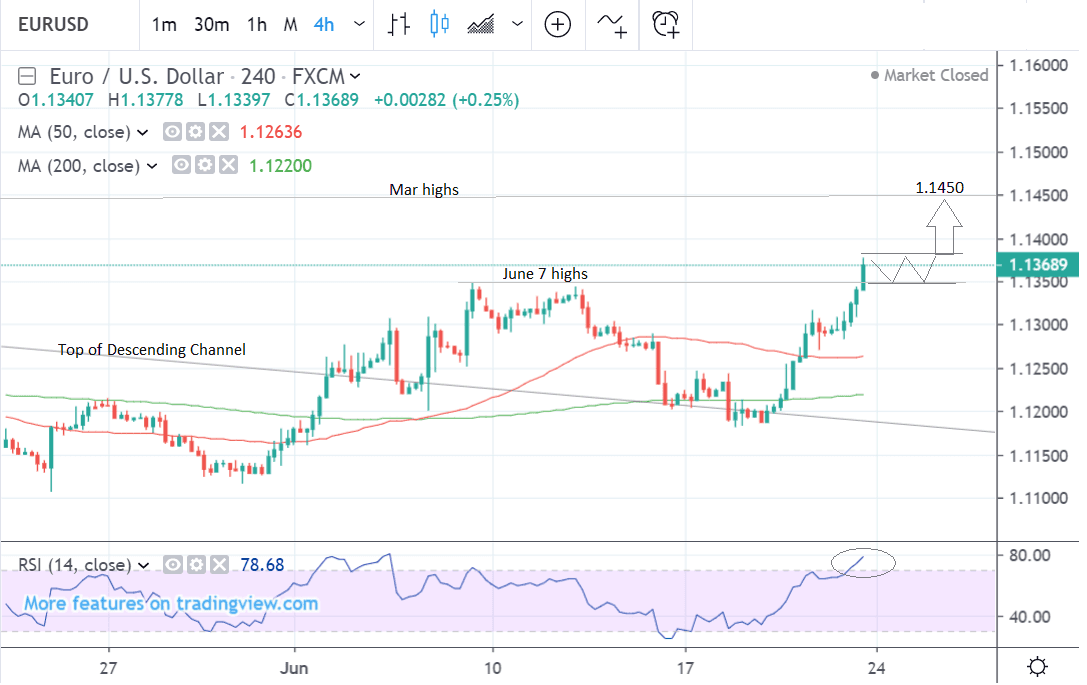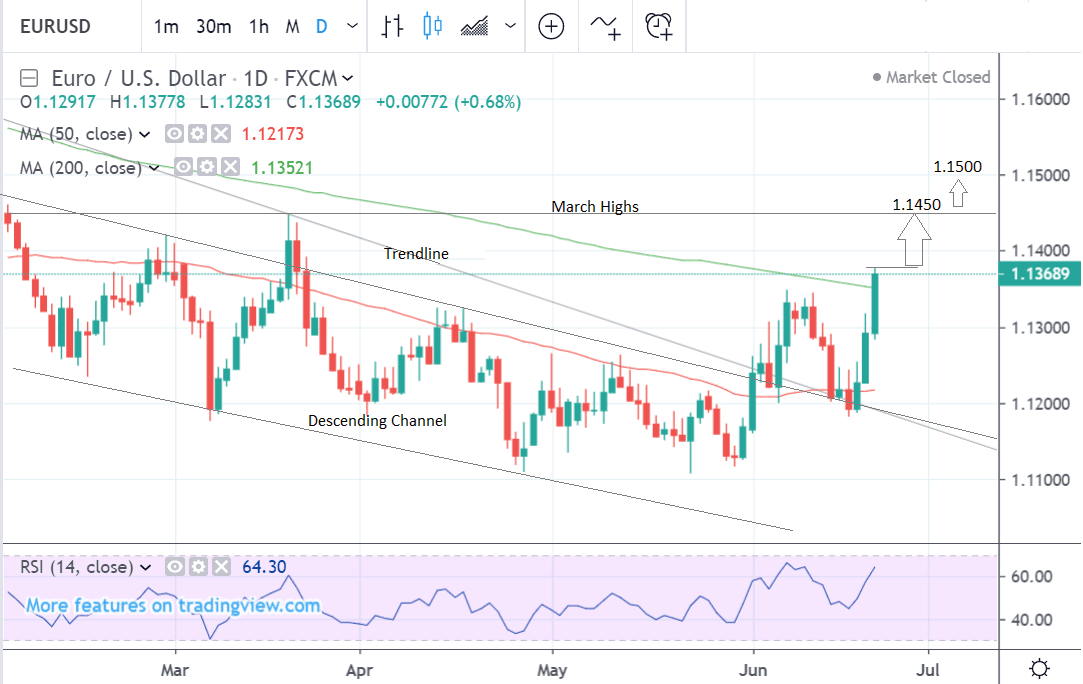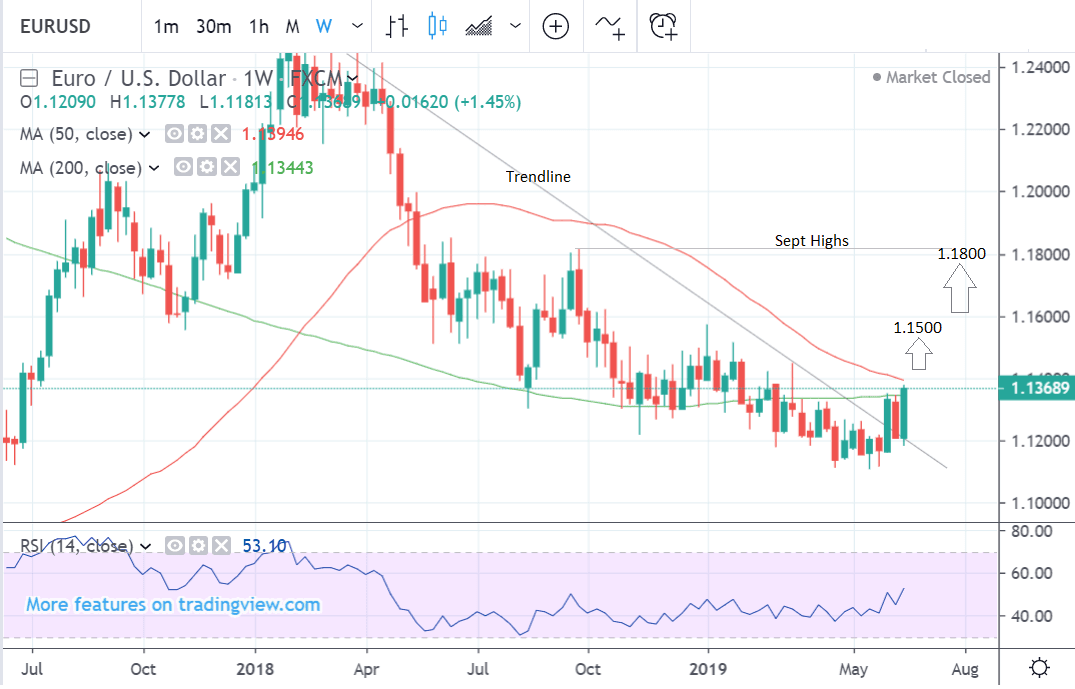EUR/USD 5-Day Forecast: Reversal Higher Takes Root, More Upside Expected but only After Potential Pullback

Image © Adobe Images
- EUR/USD bases at trendline and surges higher
- Close above 200-day MA key bullish signal
- Euro to be driven by CPI; Dollar by PCE
The Euro-to-Dollar exchange rate is trading around 1.1385 at the time of writing, having risen almost 1.5% in the previous week. Studies of the charts suggest the exchange rate will likely pull-back before continuing higher eventually.
The 4-hour chart shows how the pair fell during the first half of last week, then found a floor at the top of the previous descending channel on Wednesday. After that, it spent the rest of the week rebounding higher.
EUR/USD has now reached new highs for the month but it is also at overbought extremes. The RSI momentum indicator is well above 70, which is the sign that the pair is overbought and due a correction. There is a good chance it could now correct down to 1.1350 and move in a sideways range.
Eventually, however, we expect the short-term uptrend to continue, and a break above the 1.1378 highs would provide confirmation of a move up to a target at 1.1450 and the March highs.
We use the 4-hour chart for the short-term outlook which includes the next five trading days.
The daily chart shows how the pair pulled back down to support from both a long-term trendline and the border of a descending channel before bouncing higher, extremely strongly, on the last three days of last week.
The pair also closed above the 200-day moving average (MA) on a daily closing basis last week. Normally the exchange rate would have hit a hard ceiling at a major MA but the fact it pierced and closed above the MA is a bullish sign.
A break above the 1.1378 highs would provide confirmation of a move up to a target at 1.1450 and the March highs, followed by a move even higher, to the next target at 1.1500, in the medium-term.
We use the daily chart to give us an indication of the medium-term outlook which includes the next week to a month ahead.
The weekly chart shows how the pair broke above a major trendline 3-weeks ago pulled back down to the same trendline, and then ripped higher again. The break retest and move higher are a common bullish combination.
Ultimately we see a possibility of a new longer-term uptrend evolving and taking the pair all the way up to the next key resistance level at 1.1800, at the September 2018 highs.
We use the weekly chart to give us an idea of the longer-term outlook, which includes the next few months.
Time to move your money? Get 3-5% more currency than your bank would offer by using the services of foreign exchange specialists at RationalFX. A specialist broker can deliver you an exchange rate closer to the real market rate, thereby saving you substantial quantities of currency. Find out more here.
* Advertisement
The Euro: What to Watch
The main releases for the Euro are inflation and core inflation in June, out on Friday, June 28 at 10.00 BST.
Core inflation, which is probably the more reflective of demand, because it strips out volatile oil and food components, is forecast to rise to 1.0% in June from 0.8% in May, on a year-on-year (yoy) basis - which means compared to June 2018.
Broad inflation is expected to remain at 1.2% in June (yoy), the same as it was in May.
Inflation impacts on interest rates and the Euro. When inflation rises the European Central Bank (ECB) is forced to put up interest rates and this has a positive effect on the Euro. The opposite is true if inflation falls.
The Eurozone economy is currently struggling to generate the growth to push inflation higher, hence why we heard last week that officials were readying to unleash another round of stimulus.
The news saw the Euro take a dip in response.
It is within this context that the latest set of inflation data arrives: a stronger-than-forecast reading could generate some strength in Sterling, while a disappointing reading might trigger some further weakness.
The Dollar: What to Watch
The main release in the week ahead for the U.S. Dollar is the Personal Consumption Expenditure (PCE) Index, which is an important gauge of inflation.
PCE is expected to show a 1.6% and 0.2% rise on a yearly and monthly basis respectively, when it is released on Friday, at 13.30 BST.
The PCE is important because it is the favoured inflation metric of the Federal Reserve (Fed), who set base U.S. interest rates; and these have a major impact on the Dollar.
If PCE rises more than expected it will increase chances the Fed will not go ahead and cut interest rates as is currently expected based on commentary from their last meeting. This will push up the Dollar.
If the PCE undershoots it will increase the probability the Fed will cut rates and have a negative impact on the Dollar.
Lower interest rates weaken the Dollar by reducing net inflows of foreign capital because it makes the U.S. a less attractive place for foreign investors to park their money.
Analysts at Wells Fargo note strong spending in March and April which supports a robust PCE result in May. This suggests the probability that the metric will either hit or beat forecasts.
“The real spending level in April was up an annualized 2.2% above the Q1 average and supports our call for strong consumer spending growth in Q2. This solid spending gain will provide significant underlying support to Q2 GDP growth, which is likely to be restrained by a wider trade deficit and less inventory building,” says Wells Fargo.
Other key data releases in the week ahead for the Dollar are durable goods orders at 13.30 on Wednesday; pending home sales at 15.00 on Thursday; new homes sales and consumer confidence at 15.00 Tuesday, and commentary from Fed officials.
An important macro event for the U.S. Dollar is likely to be the G20 meeting, which starts on Friday, June 28, although the effects are unlikely to be fully absorbed until the following week.
The Dollar is likely to act as a safe-haven in relation to the G20. The main focus will be trade tensions between the U.S. and China.
If relations improve, as many analysts seem to believe is possible, the Dollar could falter, and vice versa if they worsen.
Time to move your money? Get 3-5% more currency than your bank would offer by using the services of foreign exchange specialists at RationalFX. A specialist broker can deliver you an exchange rate closer to the real market rate, thereby saving you substantial quantities of currency. Find out more here.
* Advertisement







